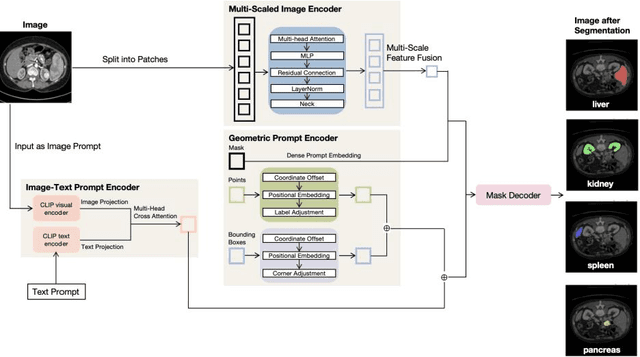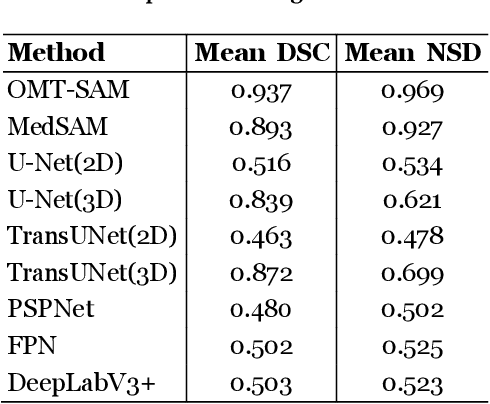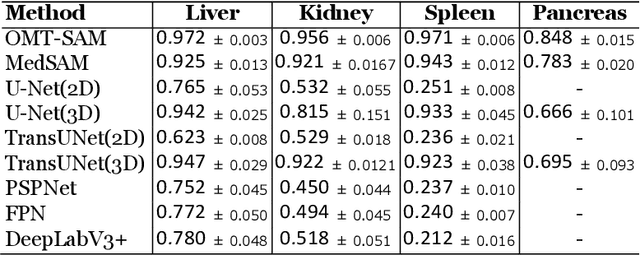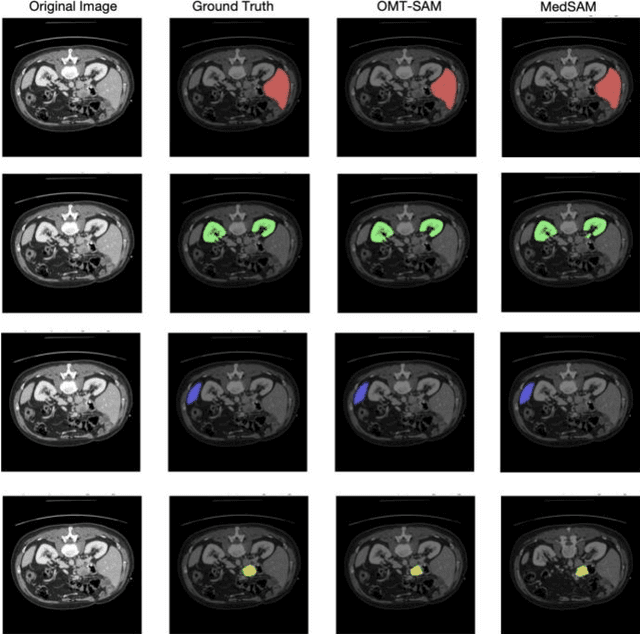Ziyang Zhang
TOM: An Open-Source Tongue Segmentation Method with Multi-Teacher Distillation and Task-Specific Data Augmentation
Aug 19, 2025Abstract:Tongue imaging serves as a valuable diagnostic tool, particularly in Traditional Chinese Medicine (TCM). The quality of tongue surface segmentation significantly affects the accuracy of tongue image classification and subsequent diagnosis in intelligent tongue diagnosis systems. However, existing research on tongue image segmentation faces notable limitations, and there is a lack of robust and user-friendly segmentation tools. This paper proposes a tongue image segmentation model (TOM) based on multi-teacher knowledge distillation. By incorporating a novel diffusion-based data augmentation method, we enhanced the generalization ability of the segmentation model while reducing its parameter size. Notably, after reducing the parameter count by 96.6% compared to the teacher models, the student model still achieves an impressive segmentation performance of 95.22% mIoU. Furthermore, we packaged and deployed the trained model as both an online and offline segmentation tool (available at https://itongue.cn/), allowing TCM practitioners and researchers to use it without any programming experience. We also present a case study on TCM constitution classification using segmented tongue patches. Experimental results demonstrate that training with tongue patches yields higher classification performance and better interpretability than original tongue images. To our knowledge, this is the first open-source and freely available tongue image segmentation tool.
KERAP: A Knowledge-Enhanced Reasoning Approach for Accurate Zero-shot Diagnosis Prediction Using Multi-agent LLMs
Jul 03, 2025Abstract:Medical diagnosis prediction plays a critical role in disease detection and personalized healthcare. While machine learning (ML) models have been widely adopted for this task, their reliance on supervised training limits their ability to generalize to unseen cases, particularly given the high cost of acquiring large, labeled datasets. Large language models (LLMs) have shown promise in leveraging language abilities and biomedical knowledge for diagnosis prediction. However, they often suffer from hallucinations, lack structured medical reasoning, and produce useless outputs. To address these challenges, we propose KERAP, a knowledge graph (KG)-enhanced reasoning approach that improves LLM-based diagnosis prediction through a multi-agent architecture. Our framework consists of a linkage agent for attribute mapping, a retrieval agent for structured knowledge extraction, and a prediction agent that iteratively refines diagnosis predictions. Experimental results demonstrate that KERAP enhances diagnostic reliability efficiently, offering a scalable and interpretable solution for zero-shot medical diagnosis prediction.
MonkeyOCR: Document Parsing with a Structure-Recognition-Relation Triplet Paradigm
Jun 05, 2025Abstract:We introduce MonkeyOCR, a vision-language model for document parsing that advances the state of the art by leveraging a Structure-Recognition-Relation (SRR) triplet paradigm. This design simplifies what would otherwise be a complex multi-tool pipeline (as in MinerU's modular approach) and avoids the inefficiencies of processing full pages with giant end-to-end models (e.g., large multimodal LLMs like Qwen-VL). In SRR, document parsing is abstracted into three fundamental questions - "Where is it?" (structure), "What is it?" (recognition), and "How is it organized?" (relation) - corresponding to layout analysis, content identification, and logical ordering. This focused decomposition balances accuracy and speed: it enables efficient, scalable processing without sacrificing precision. To train and evaluate this approach, we introduce the MonkeyDoc (the most comprehensive document parsing dataset to date), with 3.9 million instances spanning over ten document types in both Chinese and English. Experiments show that MonkeyOCR outperforms MinerU by an average of 5.1%, with particularly notable improvements on challenging content such as formulas (+15.0%) and tables (+8.6%). Remarkably, our 3B-parameter model surpasses much larger and top-performing models, including Qwen2.5-VL (72B) and Gemini 2.5 Pro, achieving state-of-the-art average performance on English document parsing tasks. In addition, MonkeyOCR processes multi-page documents significantly faster (0.84 pages per second compared to 0.65 for MinerU and 0.12 for Qwen2.5-VL-7B). The 3B model can be efficiently deployed for inference on a single NVIDIA 3090 GPU. Code and models will be released at https://github.com/Yuliang-Liu/MonkeyOCR.
AhaKV: Adaptive Holistic Attention-Driven KV Cache Eviction for Efficient Inference of Large Language Models
Jun 04, 2025Abstract:Large Language Models (LLMs) have significantly advanced the field of Artificial Intelligence. However, their deployment is resource-intensive, not only due to the large number of model parameters but also because the (Key-Value) KV cache consumes a lot of memory during inference. While several works propose reducing the KV cache by evicting the unnecessary tokens, these approaches rely on accumulated attention score as eviction score to quantify the importance of the token. We identify the accumulated attention score is biased and it decreases with the position of the tokens in the mathematical expectation. As a result, the retained tokens concentrate on the initial positions, limiting model's access to global contextual information. To address this issue, we propose Adaptive holistic attention KV (AhaKV), it addresses the bias of the accumulated attention score by adaptively tuning the scale of softmax according the expectation of information entropy of attention scores. To make use of the holistic attention information in self-attention mechanism, AhaKV utilize the information of value vectors, which is overlooked in previous works, to refine the adaptive score. We show theoretically that our method is well suited for bias reduction. We deployed AhaKV on different models with a fixed cache budget. Experiments show that AhaKV successfully mitigates bias and retains crucial tokens across global context and achieve state-of-the-art results against other related work on several benchmark tasks.
TCM-Ladder: A Benchmark for Multimodal Question Answering on Traditional Chinese Medicine
May 29, 2025Abstract:Traditional Chinese Medicine (TCM), as an effective alternative medicine, has been receiving increasing attention. In recent years, the rapid development of large language models (LLMs) tailored for TCM has underscored the need for an objective and comprehensive evaluation framework to assess their performance on real-world tasks. However, existing evaluation datasets are limited in scope and primarily text-based, lacking a unified and standardized multimodal question-answering (QA) benchmark. To address this issue, we introduce TCM-Ladder, the first multimodal QA dataset specifically designed for evaluating large TCM language models. The dataset spans multiple core disciplines of TCM, including fundamental theory, diagnostics, herbal formulas, internal medicine, surgery, pharmacognosy, and pediatrics. In addition to textual content, TCM-Ladder incorporates various modalities such as images and videos. The datasets were constructed using a combination of automated and manual filtering processes and comprise 52,000+ questions in total. These questions include single-choice, multiple-choice, fill-in-the-blank, diagnostic dialogue, and visual comprehension tasks. We trained a reasoning model on TCM-Ladder and conducted comparative experiments against 9 state-of-the-art general domain and 5 leading TCM-specific LLMs to evaluate their performance on the datasets. Moreover, we propose Ladder-Score, an evaluation method specifically designed for TCM question answering that effectively assesses answer quality regarding terminology usage and semantic expression. To our knowledge, this is the first work to evaluate mainstream general domain and TCM-specific LLMs on a unified multimodal benchmark. The datasets and leaderboard are publicly available at https://tcmladder.com or https://54.211.107.106 and will be continuously updated.
Pangu Ultra MoE: How to Train Your Big MoE on Ascend NPUs
May 07, 2025Abstract:Sparse large language models (LLMs) with Mixture of Experts (MoE) and close to a trillion parameters are dominating the realm of most capable language models. However, the massive model scale poses significant challenges for the underlying software and hardware systems. In this paper, we aim to uncover a recipe to harness such scale on Ascend NPUs. The key goals are better usage of the computing resources under the dynamic sparse model structures and materializing the expected performance gain on the actual hardware. To select model configurations suitable for Ascend NPUs without repeatedly running the expensive experiments, we leverage simulation to compare the trade-off of various model hyperparameters. This study led to Pangu Ultra MoE, a sparse LLM with 718 billion parameters, and we conducted experiments on the model to verify the simulation results. On the system side, we dig into Expert Parallelism to optimize the communication between NPU devices to reduce the synchronization overhead. We also optimize the memory efficiency within the devices to further reduce the parameter and activation management overhead. In the end, we achieve an MFU of 30.0% when training Pangu Ultra MoE, with performance comparable to that of DeepSeek R1, on 6K Ascend NPUs, and demonstrate that the Ascend system is capable of harnessing all the training stages of the state-of-the-art language models. Extensive experiments indicate that our recipe can lead to efficient training of large-scale sparse language models with MoE. We also study the behaviors of such models for future reference.
SemiETS: Integrating Spatial and Content Consistencies for Semi-Supervised End-to-end Text Spotting
Apr 14, 2025Abstract:Most previous scene text spotting methods rely on high-quality manual annotations to achieve promising performance. To reduce their expensive costs, we study semi-supervised text spotting (SSTS) to exploit useful information from unlabeled images. However, directly applying existing semi-supervised methods of general scenes to SSTS will face new challenges: 1) inconsistent pseudo labels between detection and recognition tasks, and 2) sub-optimal supervisions caused by inconsistency between teacher/student. Thus, we propose a new Semi-supervised framework for End-to-end Text Spotting, namely SemiETS that leverages the complementarity of text detection and recognition. Specifically, it gradually generates reliable hierarchical pseudo labels for each task, thereby reducing noisy labels. Meanwhile, it extracts important information in locations and transcriptions from bidirectional flows to improve consistency. Extensive experiments on three datasets under various settings demonstrate the effectiveness of SemiETS on arbitrary-shaped text. For example, it outperforms previous state-of-the-art SSL methods by a large margin on end-to-end spotting (+8.7%, +5.6%, and +2.6% H-mean under 0.5%, 1%, and 2% labeled data settings on Total-Text, respectively). More importantly, it still improves upon a strongly supervised text spotter trained with plenty of labeled data by 2.0%. Compelling domain adaptation ability shows practical potential. Moreover, our method demonstrates consistent improvement on different text spotters.
Organ-aware Multi-scale Medical Image Segmentation Using Text Prompt Engineering
Mar 18, 2025



Abstract:Accurate segmentation is essential for effective treatment planning and disease monitoring. Existing medical image segmentation methods predominantly rely on uni-modal visual inputs, such as images or videos, requiring labor-intensive manual annotations. Additionally, medical imaging techniques capture multiple intertwined organs within a single scan, further complicating segmentation accuracy. To address these challenges, MedSAM, a large-scale medical segmentation model based on the Segment Anything Model (SAM), was developed to enhance segmentation accuracy by integrating image features with user-provided prompts. While MedSAM has demonstrated strong performance across various medical segmentation tasks, it primarily relies on geometric prompts (e.g., points and bounding boxes) and lacks support for text-based prompts, which could help specify subtle or ambiguous anatomical structures. To overcome these limitations, we propose the Organ-aware Multi-scale Text-guided Medical Image Segmentation Model (OMT-SAM) for multi-organ segmentation. Our approach introduces CLIP encoders as a novel image-text prompt encoder, operating with the geometric prompt encoder to provide informative contextual guidance. We pair descriptive textual prompts with corresponding images, processing them through pre-trained CLIP encoders and a cross-attention mechanism to generate fused image-text embeddings. Additionally, we extract multi-scale visual features from MedSAM, capturing fine-grained anatomical details at different levels of granularity. We evaluate OMT-SAM on the FLARE 2021 dataset, benchmarking its performance against existing segmentation methods. Empirical results demonstrate that OMT-SAM achieves a mean Dice Similarity Coefficient of 0.937, outperforming MedSAM (0.893) and other segmentation models, highlighting its superior capability in handling complex medical image segmentation tasks.
HIF: Height Interval Filtering for Efficient Dynamic Points Removal
Mar 10, 2025Abstract:3D point cloud mapping plays a essential role in localization and autonomous navigation. However, dynamic objects often leave residual traces during the map construction process, which undermine the performance of subsequent tasks. Therefore, dynamic object removal has become a critical challenge in point cloud based map construction within dynamic scenarios. Existing approaches, however, often incur significant computational overhead, making it difficult to meet the real-time processing requirements. To address this issue, we introduce the Height Interval Filtering (HIF) method. This approach constructs pillar-based height interval representations to probabilistically model the vertical dimension, with interval probabilities updated through Bayesian inference. It ensures real-time performance while achieving high accuracy and improving robustness in complex environments. Additionally, we propose a low-height preservation strategy that enhances the detection of unknown spaces, reducing misclassification in areas blocked by obstacles (occluded regions). Experiments on public datasets demonstrate that HIF delivers a 7.7 times improvement in time efficiency with comparable accuracy to existing SOTA methods. The code will be publicly available.
MedUnifier: Unifying Vision-and-Language Pre-training on Medical Data with Vision Generation Task using Discrete Visual Representations
Mar 06, 2025



Abstract:Despite significant progress in Vision-Language Pre-training (VLP), current approaches predominantly emphasize feature extraction and cross-modal comprehension, with limited attention to generating or transforming visual content. This gap hinders the model's ability to synthesize coherent and novel visual representations from textual prompts, thereby reducing the effectiveness of multi-modal learning. In this work, we propose MedUnifier, a unified VLP framework tailored for medical data. MedUnifier seamlessly integrates text-grounded image generation capabilities with multi-modal learning strategies, including image-text contrastive alignment, image-text matching and image-grounded text generation. Unlike traditional methods that reply on continuous visual representations, our approach employs visual vector quantization, which not only facilitates a more cohesive learning strategy for cross-modal understanding but also enhances multi-modal generation quality by effectively leveraging discrete representations. Our framework's effectiveness is evidenced by the experiments on established benchmarks, including uni-modal tasks (supervised fine-tuning), cross-modal tasks (image-text retrieval and zero-shot image classification), and multi-modal tasks (medical report generation, image synthesis), where it achieves state-of-the-art performance across various tasks. MedUnifier also offers a highly adaptable tool for a wide range of language and vision tasks in healthcare, marking advancement toward the development of a generalizable AI model for medical applications.
 Add to Chrome
Add to Chrome Add to Firefox
Add to Firefox Add to Edge
Add to Edge